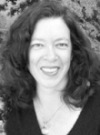 By Karen Mercury
By Karen MercuryWhen gold was discovered in California by James Marshall and his men at Sutter's Mill in January 1848, it set in motion the largest migration of humans since the Crusades. In mid-May Samuel Brannan, the leader of a ship of 200 Mormons who had arrived two years before, calculatedly jogged through the streets of "downtown" San Francisco waving a bottle of gold dust and shouting "Gold! Gold from the American River!"
Overnight the population of that town dropped from several hundred to a dozen. (The sly Brannan had made sure to buy up every gold pan and shovel in the state to stock his store before making this historic advertisement. An ordinary gold pan that cost twenty cents went for $8-16 at Brannan's store.) The blacksmith dropped his hammer, the carpenter his plane, and the mason his trowel in order to race to the "diggings" near Sacramento.
The discovery wasn't revealed in the East ("The States") until August in the New York Herald, which predicted enough gold would be taken from the country to pay a hundred times over for the recent California war with Mexico. This announcement marked 1849 as the year the world rushed in, forever changing the manifest destiny of the country, and the face and terrain of California.
 However, the unsung second significant gold strike occurred a few weeks after Marshall's original discovery in February 1847. Marshall had several men of the Mormon Battalion working with him at the mill that day, so when Henry Bigler told some of his friends about the find, they struck off on their own while pretending to hunt for duck. Halfway between the mill and Sutter's Fort, they hit the big time. They made themselves a crude wooden scale, putting a Mexican real in one pan and their dust in another.
However, the unsung second significant gold strike occurred a few weeks after Marshall's original discovery in February 1847. Marshall had several men of the Mormon Battalion working with him at the mill that day, so when Henry Bigler told some of his friends about the find, they struck off on their own while pretending to hunt for duck. Halfway between the mill and Sutter's Fort, they hit the big time. They made themselves a crude wooden scale, putting a Mexican real in one pan and their dust in another. At the ratio of 16 to 1, the going differential in price between the two metals, by nightfall they reckoned they had earned $10. They named the area Mormon Island, and by April they were washing up to $250 in dust a day using Indian blankets as sieves. This at a time when in the thirty states a day's hard labor rarely brought more than $1.50. Brannan visited the boomtown and immediately grubstaked his brethren to a one-third interest in their claim.
Mormons who had once intended to colonize Yerba Buena (San Francisco) made tracks for Mormon Island. At its height, the town had 2500 residents, four hotels, seven saloons, and a school.
In July Lt. William Tecumseh Sherman, stationed at Monterey, departed for the mines with Governor Mason to verify reports. "I of course could not escape the infection," he wrote. At Mormon Island they found three hundred Mormons laboring in the broiling heat with an early form of a "rocker" that washed and sifted sand and gravel. The hillsides were dotted with makeshift shanties and canvas tents. "I recall the scene as perfectly to-day as though it were yesterday," Sherman wrote nearly thirty years later. "On its [American River] edges men were digging, and filling buckets with the finer earth and gravel." The four men operating the "rude machine" they called a cradle, Sherman said, "could earn from forty to one hundred dollars a day." Sam Brannan oversaw all "as the high-priest, collecting the tithes." When a miner asked Mason, "Governor, what business has Sam Brannan to collect the tithes here?" Mason answered, "Brannan has a perfect right to collect the tax if you Mormons are fools enough to pay it."
 Sutter, one of California's earliest pioneers and on whose land Marshall first "found something shining," proved to be the biggest loser in the whole gold fever period. He could not prevent the tens of thousands of would-be miners and squatters from invading his land, and the Indians and Kanakas (Hawaiians) who performed most of his labor were lured away to work for newcomers. He tried his hand at mining in 1847 but soon abandoned it and returned to his fort, a spectator to his ruination, watching the flood of gold hunters stream up from San Francisco and over the Sierra Nevada.
Sutter, one of California's earliest pioneers and on whose land Marshall first "found something shining," proved to be the biggest loser in the whole gold fever period. He could not prevent the tens of thousands of would-be miners and squatters from invading his land, and the Indians and Kanakas (Hawaiians) who performed most of his labor were lured away to work for newcomers. He tried his hand at mining in 1847 but soon abandoned it and returned to his fort, a spectator to his ruination, watching the flood of gold hunters stream up from San Francisco and over the Sierra Nevada.San Francisco was nearly a ghost town; everyone had "gone to the mines." Edward Kemble, who had come from New York with Brannan two years earlier, suspended publication of their California Star newspaper, as there was no one left to buy it. The final line Kemble wrote in the paper was "We have done. Let our word of parting be Hasta Luego."